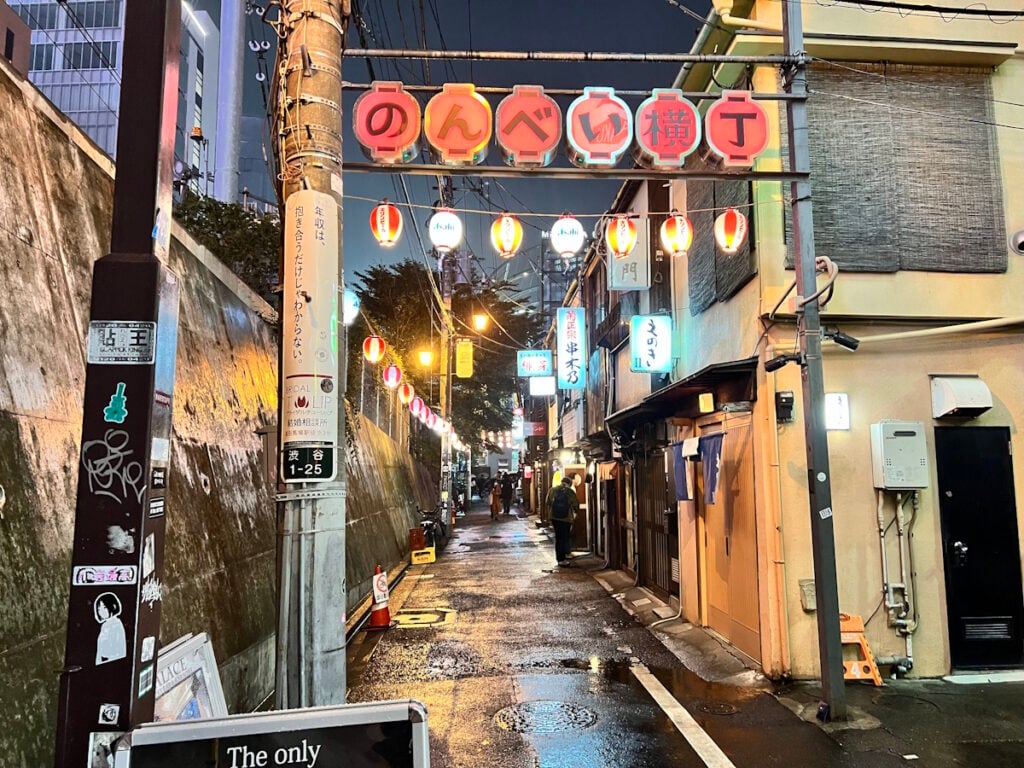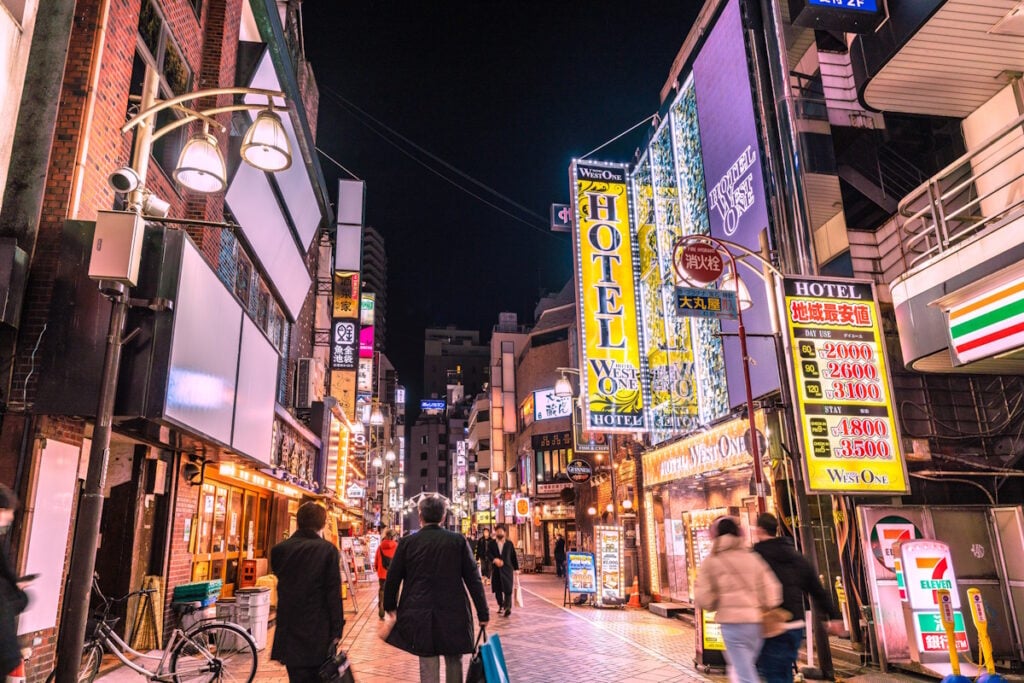In the dense urban landscape of Tokyo, it’s easy to focus on the sights in front of you: crowds of thousands emerging from packed train stations at rush hour; expanses of restaurants and izakayas; small roadside shrines next to blinking lights and trains passing through level crossings. The real extent of Tokyo, however, goes beyond your horizontal view. In the Japanese capital, don’t forget to look up!
In Japan’s nightlife districts, drinking and hostess establishments are stacked one on top of the other in prototypical Zakyo buildings, the architectural style that the Tokyo of the public imagination is made of. Huge skyscrapers soar above business districts like Marunouchi and Nishi-Shinjuku. An outdated way to refer to the three-dimensional Tokyo landscape was “organized chaos;” but if that term lacks awareness of the intentionality of Tokyo urban design, one physical reality still deserves the “chaotic” descriptor. And it’s something you only really notice when looking up: Japanese power lines.
Dense black cables are strung from utility pole to utility pole, crisscrossing the areas above streets and obscuring views of the (frequently overcast) Tokyo skies. The cables are so omnipresent that residents can almost forget they’re there, like the way your eyeglasses frames seem to disappear from your field of vision once worn for long enough.
That necessity of masses of utility cables isn’t exactly surprising in as technology-dependent a city as Japan’s capital. They provide homes, businesses, and facilities with more than just electricity: internet, phone services, and cable television rely on the vast network of power lines that blanket the urban Japanese landscape. What may be surprising, though, is that the cables remain in the open air, rather than buried beneath the earth.

Table of Contents
ToggleWhy the Japanese Sky Remains Obscured
The perceived chaos may not be able to hold a candle to spaghetti-like power line formations found in parts of countries like Thailand or India, but the density of cables is still enough to turn a few heads. In fact, a study by the Japanese Ministry of Land, Infrastructure, Transport and Tourism proved the comparative prominence of above-ground power lines in Tokyo and Osaka compared to other major world cities. As of 2019, London, Paris, Hong Kong, and even nearby Taipei had reached 100% subterranean power line placement. Comparatively, the 23 wards that make up central Tokyo had only reached a minuscule 8%; the vast majority of Tokyo’s power lines remained above-ground. So, you’re not just imagining things – there really are more above-ground power lines in Japan than elsewhere. The question is, why?

Japan is Covered in Electrical Wires – Why?
Look up in a Japanese city, and you’re likely to see a sky view partly obscured by power lines. Here’s why Japan’s utility lines are more visible than those in other advanced economies.
Power Lines a Plenty
This city-focused study is a relatively small sample size, so let’s look at a more extensive one. This comparison between Japan to the states of the EU showed that Japan trailed behind even the European countries with the most visible power lines, like Greece (at 11.2% subterranean power lines) and Ireland (at 17.5%). Japan had only reached a mere 0.3%. Comparatively, countries like Denmark, Luxembourg, Germany, and the UK all had achieved more than 80% underground power lines.

There are a number of reasons why other countries have chosen to underground their utility lines. One is pretty instinctual: power lines are ugly. Utilities are an unsightly reminder of the vast network of infrastructure necessary for our societies to function. They’re brutalist, mechanical, and their presence upsets both the natural and intentional aesthetics of the places we live. A 2006 study in England and Wales found that a massive 87% of respondents preferred underground cables to aerial cabling (Atkinson et al., 2006). Undergrounding can lead to a more pleasant urban space for both residents and visitors.
The more practical reasons for undergrounding include the reliability provided by an underground electrical grid. Above-ground cables are more susceptible to environmental factors. High winds and storms can down utility poles; snow build-up can cause utility collapse. Animals can gnaw into cables, and profit-minded thieves can more easily steal utility parts.
Why Japanese Power Lines Remain an Outlier
Notably, Japanese power lines are mostly what’s known as “aerial cables.” These are insulated, as opposed to the naked power lines one sees on high-up power lines in the American countryside. This helps prevent dangerous direct contact between animals (or wayward humans) and the wires’ deadly electric currents.
Such aerial cables are still vulnerable to the typhoons that regularly buffet Japan’s coasts, however. In 2019, for example, Typhoon Faxai made landfall in Chiba Prefecture, its powerful winds downing almost 2000 utility poles. Over 930,000 homes lost electricity.
Planning a trip to Japan? Get an authentic, interpreted experience from Unseen Japan Tours and see a side of the country others miss!

"Noah [at Unseen Japan] put together an itinerary that didn’t lock us in and we could travel at our own pace. In Tokyo, he guided us personally on a walking tour. Overall, he made our Japan trip an experience not to forget." - Kate and Simon S., Australia

See a side of Tokyo that other tourists can't. Book a tour with Unseen Japan Tours - we'll tailor your trip to your interests and guide you through experiences usually closed off to non-Japanese speakers.


Want more news and views from Japan? Donate $5/month ($60 one-time donation) to the Unseen Japan Journalism Fund to join Unseen Japan Insider. You'll get our Insider newsletter with more news and deep dives, a chance to get your burning Japan questions answered, and a voice in our future editorial direction.

Nonetheless, there is one type of natural disaster that underground power lines are susceptible to: earthquakes. When powerful quakes disturb or sever underground lines, repair can take much longer than with above-ground power lines. A partially damaged above-ground power line can be repaired in minutes; digging up, finding, isolating, and repairing underground systems can sometimes take weeks.
So, Earthquakes would seem to be the most obvious reason for Japan’s aerial power lines. Reality, though, is not actually so cut and dried. The Network for Non Pole Community (電線ない街づくり支援ネットワーク), an organization dedicated to reducing utility pole presence in Japan, has discussed the secondary damages caused by utility pole collapse during the devastating 1995 Great Hanshin Earthquake. Areas with more above-ground utility poles, they say, suffered more damage. Downed poles also prevented emergency vehicles from easily navigating the streets of devastated Kobe. So, Japan’s noted seismic activity cuts both ways in the aerial-vs-undergrounding debate.
The Real Culprit: Budgetary Concerns?
What seems to create the biggest hurdle to power line undergrounding is something a bit less exciting than earthquakes or aesthetics. Undergrounding of utilities is expensive. In most countries, you can expect up-front costs for subterranean power line installation to be two to four times costlier than aerial alternatives. Additionally, undergrounding is often more expensive in Japan than other advanced economies. For example, renewable energy media site Hatch reports that undergrounding in Japan costs nearly 20% more than in France. Hatch also reports that regulations concerning underground cable laying are more complex in Japan than elsewhere. Just obtaining permissions to lay electrical wires in Japan’s complex map of municipalities and special wards can be a nightmare.
This isn’t to say that localities don’t want to get rid of utility poles and unsightly power lines. Various government initiatives have looked into the benefits of doing just that. But just like the web of electrical wires that blanket the Japanese skyscape, the pros and cons create a complicated situation. Take the ubiquitous utility poles of Tokyo: on the one hand, poles are useful locations for posting addresses and public announcement signage in often confusing urban streetscapes. On the other, poles take up valuable real estate and decrease accessibility by making narrow streets more difficult for wheelchair users to traverse.
There’s also the fact that omnipresent electrical wires have been around for long enough to become part of the perceived imagery of Japanese public spaces. In 2014, Huffington Post‘s JPN edition reported on how a visual created to highlight powerline ugliness backfired: Hokusai’s famed “Red Fuji” looks strangely atmospheric with a mass of electricity cables in front of it.

Anime: Full of Power Lines
Imagery of drooping utility lines over Japanese cityscapes found in anime, manga, and live action media has helped impart a feeling of atmosphere to otherwise unappealing infrastructure. Perhaps no series has done so as influentially as 1998’s psychological techno-drama Serial Experiments Lain. The series’ surreal imagery of electrical wires dominating ordinary Japanese cityscapes, powering an internet that is slowly replacing reality, was so effective that you can now find YouTube videos like “12 Hours of Powerline Noise from Serial Experiments Lain” with over a million views. Neon Genesis Evangelion, the epoch-making anime from 1995, is just one more series to ingrain images of modern Japanese infrastructure into the global sci-fi imagination.
This imagery is powerful enough that its reach extends beyond the borders here in Japan – I recently had a friend visit for the first time from the States, and when I pointed out the ubiquitous power lines, he said that the sight felt strangely nostalgic. Japanese media depictions of utility wires in the local landscape have created a type of borrowed nostalgia abroad for another country’s infrastructure. It’s fascinating.

A Historical Basis
Ideas like earthquake readiness being the reason for wire-festooned skies belie the history of how Japan’s modern electrical grid emerged. While above-ground utilities were the norm in the early days, pre-war Japan was working towards an undergrounded future. Tokyo’s Bunkyo Ward was one locality that was actively striving to bury power lines before the war. In Japan’s colonial empire, new towns developed in the puppet state of Manchukuo were designed with underground power lines in mind.

But the wartime firebombing of the majority of Japan’s urban spaces put an end to the long game of undergrounding. With most cities in Japan left in bombed-out devastation, the quick rebuilding of infrastructure and utilities took precedence. Above-ground power lines were far faster and cheaper to build than underground alternatives. Initially, these were to be a stop-gap; undergrounding would follow when time and funds allowed.
Then, as Japan quickly emerged from stark post-war poverty into a skyrocketing modern economy, electricity demands exploded. Japan’s cities expanded, and utility poles, with their wiring for electricity and phone lines, were installed by the thousands. Japan needed more access to electricity, and fast; there wasn’t any time for subterranean wire laying. What was once meant to be a temporary facet of urban design emerged as something more permanent.
Planning a trip to Japan? Get an authentic, interpreted experience from Unseen Japan Tours and see a side of the country others miss!

"Noah [at Unseen Japan] put together an itinerary that didn’t lock us in and we could travel at our own pace. In Tokyo, he guided us personally on a walking tour. Overall, he made our Japan trip an experience not to forget." - Kate and Simon S., Australia

See a side of Tokyo that other tourists can't. Book a tour with Unseen Japan Tours - we'll tailor your trip to your interests and guide you through experiences usually closed off to non-Japanese speakers.


Want more news and views from Japan? Donate $5/month ($60 one-time donation) to the Unseen Japan Journalism Fund to join Unseen Japan Insider. You'll get our Insider newsletter with more news and deep dives, a chance to get your burning Japan questions answered, and a voice in our future editorial direction.
So, the current power line status quo wasn’t some natural progression necessitated by Japan’s physical geography. Instead, it’s the result of Japan’s rapid metamorphosis from wartime devastation to an electricity-consuming economic powerhouse. Japan’s urban landscape is in a state of constant flux; things could certainly still change. But given the sheer scale of converting Japan’s mass of wiring from above to below, we shouldn’t expect the view of Tokyo’s skies to become fully unadulterated any time soon.

Discover the “unseen” side of Japan
Japan is on everyone’s travel bucket list. Sadly, many end up going to the same places as everyone else. That can turn what could have been a fun, once-in-a-lifetime experience into an exhausting battle with crowds.
We started Unseen Japan Tours for the same reason we started Unseen Japan: To give people a unique glimpse into Japan they can’t get anywhere else. Let us create a custom itinerary of hard-to-find spots centered on your interests. We can also serve as your guides and interpreters, taking you to places that non-Japanese-speaking tourists usually can’t access.
Contact us below to get the ball rolling today!
What to read next

Halal Ramen in Tokyo: A Look at the Expanding Scene
Wanna enjoy one of Japan’s signature dishes but still stay halal? These five shops in Tokyo serve noodles without the pork and booze.

Tokyo’s Top 10 Drinking Neighborhoods – And Why Shibuya Doesn’t Make the Cut
Where do you go in Tokyo to grab some drinks and bond with friends? For many in the city, the answer is increasingly “not Shibuya.”

Tokyo Girls Bar Workers Allegedly Forced Woman Into Prostitution
A popular and well-respected girls bar in Ikebukuro was reportedly the scene of a horrific case of abuse and sexual slavery.
Sources
2022.03.17. 日本ではなぜ無電柱化が進まない? 電柱の整備状況と地中化に向けた国内外の取り組み. HATCH.
2017年11月26日. なぜ日本では「電線の地中化」が進んでいないのか? ねとらぼ.
安藤健二. (2014年07月13日). 赤富士が電線だらけ… 啓発イラストが「カッコよくて逆効果」と話題に【無電柱化民間プロジェクト】. The Huffington Post
Baseel, Casey. Sep. 26, 2014. Why does Japan have so many overhead power lines? Japan Today.

